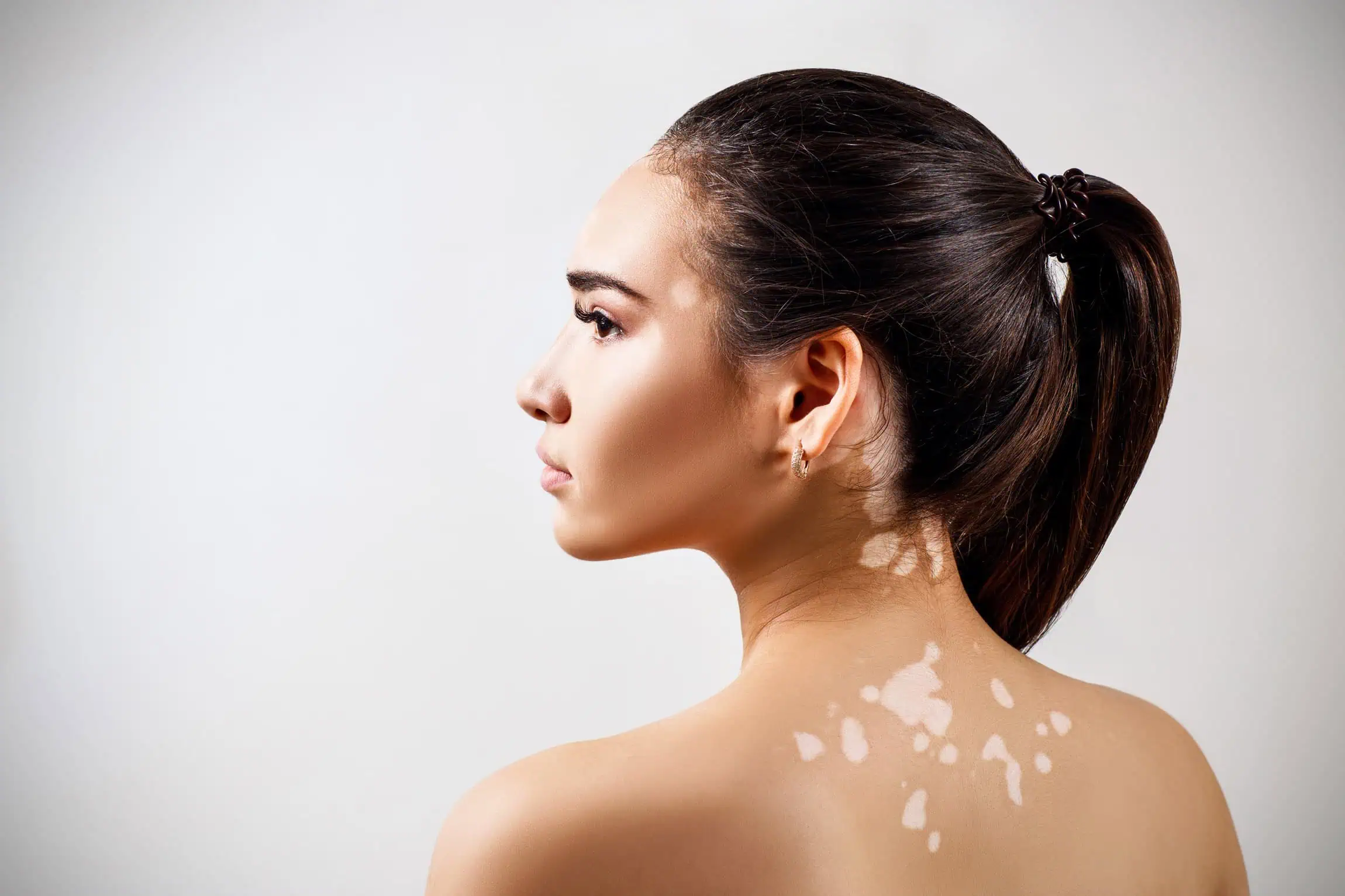Vitiligo in New York, NY

Vitiligo in New York, NY
Vitiligo is a skin condition characterized by the loss of pigmentation in some skin regions, leading to white or lighter patches. This condition occurs when the pigment-producing cells, called melanocytes, are destroyed or cease functioning. Vitiligo can affect any body part and may appear in small spots or large patches. The underlying cause of Vitiligo is not fully understood, but it is often thought to be related to autoimmune processes, genetic factors, or environmental triggers. Vitiligo does not typically cause pain or other physical symptoms, but it can have significant cosmetic and psychological effects on those affected.
What causes Vitiligo?
Vitiligo is mainly caused by an autoimmune response, where the immune system mistakenly attacks the cells that produce skin color, called melanocytes. When these cells are damaged or destroyed, it leads to lighter patches of skin. Genetics also play a role, as the condition can run in families, suggesting a hereditary link. Other factors contributing to Vitiligo include skin damage from sunburn or cuts and stress. These factors can sometimes trigger or worsen the condition, especially in people who are already genetically predisposed.
What are the different procedures for treating Vitiligo?
Topical Corticosteroids
Creams or ointments are applied straight to the affected areas to soothe inflammation and attempt to restore pigment. They are often used for small patches of Vitiligo and may help to repigment the skin over time.
Phototherapy
This treatment involves exposing the skin to ultraviolet (UV) light under medical supervision. It is commonly used for widespread Vitiligo. Phototherapy helps stimulate melanocyte activity and can promote repigmentation, particularly when combined with other treatments.
Excimer Laser Therapy
This type of phototherapy uses a specific wavelength of UV light to target vitiligo patches. It is particularly effective for small areas of the skin and aims to stimulate pigment production in the affected areas.
Skin Grafting
In cases where other treatments are ineffective, skin grafting may be considered. This procedure involves taking healthy skin from one part of the body and transplanting it to the vitiligo-affected areas. This method is generally used for stable Vitiligo where the condition has not progressed for some time.
Depigmentation Therapy
Depigmentation therapy may be used for extensive Vitiligo, where repigmentation is not feasible. This involves using medications to lighten the unaffected areas of the skin to match the lighter patches.
Cosmetic Cover-ups
Non-medical options such as makeup and self-tanner can camouflage the white patches of skin. These products do not treat Vitiligo but can help improve appearance and confidence.
What are the results of Vitiligo treatments?
The results of vitiligo treatments can vary according to the treatment, the extent of the condition, and individual response. Topical corticosteroids and phototherapy may help in repigmenting small to moderate patches of skin, though results can be gradual and require ongoing treatment. Excimer laser therapy often shows good results for localized areas. Skin grafting can provide long-term results but is generally reserved for stable cases. Depigmentation therapy can be effective for unifying skin color in extensive cases. Cosmetic cover-ups offer immediate improvement in appearance but do not affect the underlying condition.
Park Plaza Dermatology offers specialized care for those seeking effective vitiligo treatment options in New York, NY. Book an appointment with our experienced team to explore personalized treatment plans and achieve the best possible results for managing Vitiligo. Our vitiligo specialists in NYC are here to help you with customized treatment in NYC.
Benefits of Vitiligo Treatment include
- It helps restore skin pigmentation
- Reduces the appearance of white patches
- Improves skin uniformity and appearance
- Addresses cosmetic and psychological impact
- Offers various treatment options to suit different cases
- It may improve quality of life and self-esteem
- Provides targeted approaches for specific areas
- It can be combined with other therapies for enhanced results
- Non-surgical options available for mild to moderate cases
- Personalized treatment plans based on individual needs
Frequently Asked Questions
The primary goal of vitiligo treatment is to restore skin pigmentation and improve the appearance of white patches. Treatment aims to repigment affected areas, reduce the contrast between normal and depigmented skin, and enhance the overall aesthetic appearance.
The time to see results from vitiligo treatments can vary. Topical treatments may take several weeks to months to show noticeable changes. Phototherapy and laser treatments typically require multiple sessions over several months for optimal results. Skin grafting results can be seen in a few months after the procedure.
Yes, some vitiligo treatments can have side effects. Topical corticosteroids might cause skin thinning or irritation. Phototherapy and laser treatments may lead to redness or burning. Skin grafting can result in scarring or mismatched skin color. It is essential to discuss potential side effects with your dermatologist.
At present, there is no complete cure for Vitiligo. The condition is chronic and requires ongoing management. However, various treatments can help manage Vitiligo, improve skin pigmentation, and reduce the appearance of white patches. These treatments can be effective in restoring some pigment and minimizing the visibility of affected areas, but results vary depending on factors such as the patient’s response to treatment, the extent of the Vitiligo, and the duration of the condition.
Coverage for vitiligo treatments can vary depending on the insurance plan. Some treatments, such as topical corticosteroids and phototherapy, may be covered, while others, like cosmetic cover-ups or specific advanced therapies, might not be. It is best to check with your insurance provider for specific coverage details.
Vitiligo treatments can often be combined with other therapies for enhanced results. For instance, phototherapy may be used alongside topical treatments or excimer laser therapy might be combined with skin grafting. Combining therapies must be done under the guidance of a dermatologist to ensure quality, safety, and effectiveness.
